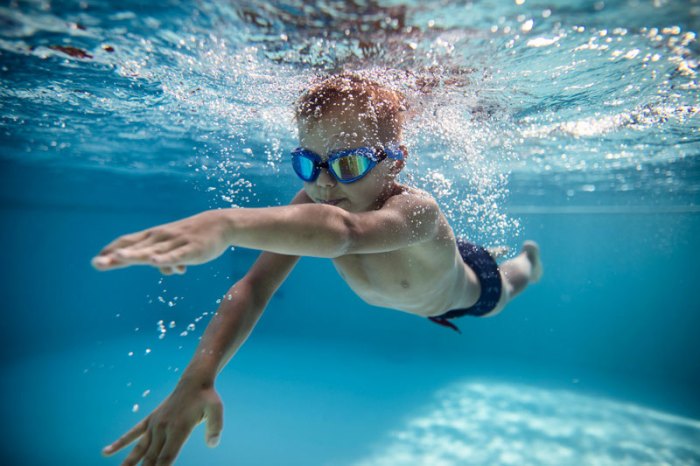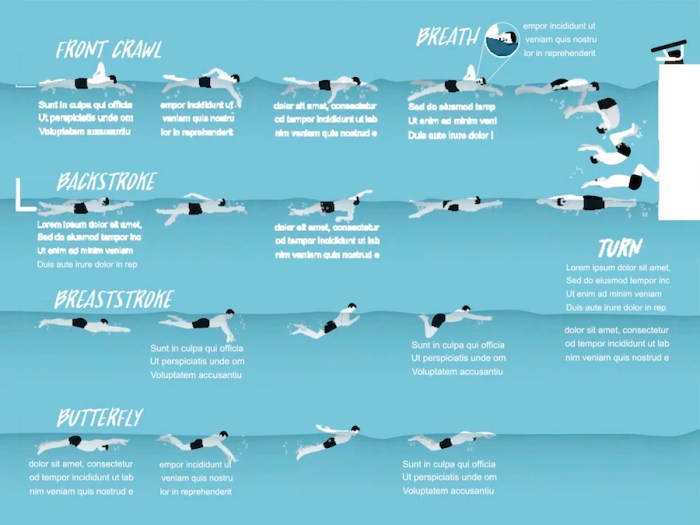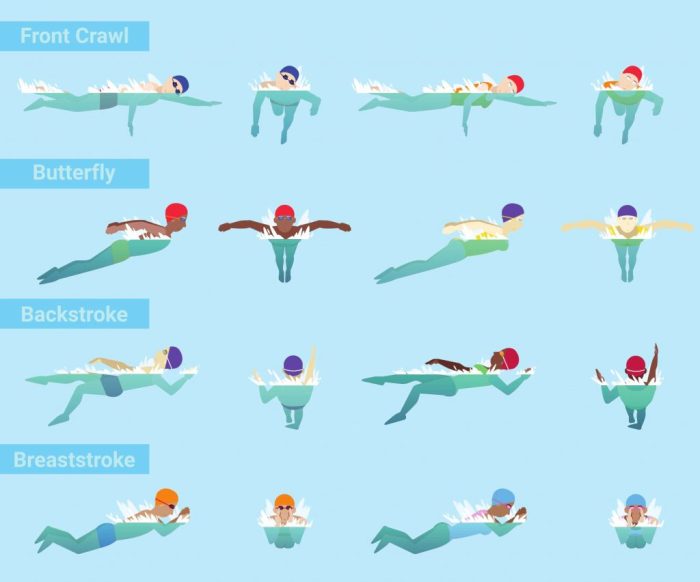Dive into the world of swimming with “How to Swim: 8 Basic Swimming Strokes,” where we explore the essential techniques and skills needed to navigate the waters with confidence and ease. Whether you’re a beginner looking to improve your strokes or a seasoned swimmer aiming to refine your technique, this guide has you covered. Let’s jump in!
In this comprehensive guide, we will delve into the intricacies of each basic swimming stroke, uncovering the secrets to mastering them effectively. From freestyle to butterfly, backstroke to breaststroke, we’ll break down the nuances of each stroke to help you become a proficient swimmer.
Introduction to Basic Swimming Strokes

Swimming is a valuable life skill that offers not only a fun way to stay active but also vital water safety knowledge. Learning different swimming strokes is essential to becoming a proficient swimmer as each stroke serves a specific purpose and is beneficial in various swimming situations.
Benefits of Mastering Various Strokes
- Improves overall swimming technique and efficiency.
- Provides a full-body workout by engaging different muscle groups.
- Increases endurance and cardiovascular fitness.
- Enhances coordination and agility in the water.
Usage of Each Stroke in Different Swimming Situations
- Freestyle: Ideal for long-distance swimming and racing due to its speed and efficiency.
- Backstroke: Helps swimmers maintain awareness of their surroundings and is often used for recreational swimming.
- Breaststroke: Commonly used in beginner swimming lessons for its simplicity and focus on proper breathing techniques.
- Butterfly: Known for its challenging nature, butterfly stroke is used in competitive swimming events such as the butterfly stroke race.
List of 8 Basic Swimming Strokes

Learning the 8 basic swimming strokes is essential for any beginner looking to improve their swimming skills. Each stroke requires a different technique and serves a specific purpose in swimming.
1. Freestyle Stroke
The freestyle stroke, also known as front crawl, is the fastest and most common stroke used in swimming competitions. Swimmers propel themselves through the water with an alternating arm motion while kicking their legs.
Common mistakes beginners make:
- Incorrect breathing technique, such as holding their breath instead of exhaling underwater.
- Improper arm movement, like crossing over the centerline of the body.
- Weak kick or incorrect flutter kick technique.
2. Backstroke
Backstroke involves swimming on your back while performing an alternating arm motion and flutter kick. It is a great stroke for beginners as it allows them to breathe easily without turning their head to the side.
Common mistakes beginners make:
- Not keeping their body position horizontal, causing drag in the water.
- Inconsistent arm movement, leading to an uneven stroke rhythm.
- Incorrect head position, looking forward rather than up towards the ceiling.
3. Breaststroke
Breaststroke is characterized by a frog-like kick, simultaneous arm movement, and a glide phase. It is a slower stroke but requires good coordination between the arms and legs.
Common mistakes beginners make:
- Incorrect timing of the arm pull and kick, leading to a choppy stroke.
- Overgliding or rushing the arm recovery, disrupting the stroke rhythm.
- Not keeping their head in a neutral position, causing resistance in the water.
4. Butterfly Stroke
Butterfly is a challenging stroke that involves a dolphin kick, simultaneous arm pull, and breathing technique. It is a powerful stroke but requires strength and coordination to execute properly.
Common mistakes beginners make:
- Weak dolphin kick, resulting in a lack of propulsion through the water.
- Improper arm movement, such as a wide or inefficient pull, leading to fatigue.
- Incorrect breathing timing, causing swimmers to struggle with breath control.
5. Sidestroke
Sidestroke is a relaxed and efficient stroke that involves a scissor kick, asymmetrical arm movement, and minimal head movement. It is often used for long-distance swims or in lifesaving situations.
Common mistakes beginners make:
- Uneven arm pull, causing imbalance in the stroke and reducing efficiency.
- Incorrect scissor kick technique, leading to drag in the water.
- Not maintaining a streamlined body position, slowing down progress in the water.
6. Elementary Backstroke
Elementary backstroke is a simple stroke that involves a floating position, frog-like kick, and a synchronized arm movement. It is often taught to beginners as an introduction to swimming techniques.
Common mistakes beginners make:
- Incorrect arm movement, such as pulling too early or too late in the stroke cycle.
- Weak kick or lack of propulsion, causing swimmers to struggle to move through the water.
- Not maintaining a relaxed and controlled breathing pattern, leading to fatigue.
7. Trudgen Stroke
The trudgen stroke combines elements of the freestyle and butterfly strokes, including a flutter kick, alternating arm pull, and breathing to one side. It is an older stroke that is less commonly used in modern swimming competitions.
Common mistakes beginners make:
- Incorrect coordination between the arm pull and kick, disrupting the stroke rhythm.
- Irregular breathing pattern, making it challenging to maintain a steady pace in the water.
- Overreaching or crossing over the centerline of the body with the arms, causing resistance.
8. Combat Side Stroke
Combat side stroke is a survival stroke used by the military that involves a scissor kick, modified freestyle arm pull, and minimal head movement. It is designed for efficiency and endurance in open water situations.
Common mistakes beginners make:
- Incorrect arm positioning, leading to an inefficient pull through the water.
- Weak or improper scissor kick technique, reducing propulsion and speed.
- Not maintaining a consistent breathing pattern, causing fatigue during long swims.
Tips for Mastering Basic Swimming Strokes

To improve your efficiency in basic swimming strokes, it is essential to focus on proper technique, body position, and breathing. Here are some tips to help you master the 8 basic swimming strokes.
Practice Drills for Stroke Efficiency
- Freestyle: Practice bilateral breathing to improve symmetry and balance in the water.
- Backstroke: Work on your body rotation to maximize propulsion and reduce drag.
- Breaststroke: Focus on the timing of your kick and pull to maintain a smooth and efficient stroke.
- Butterfly: Incorporate dolphin kick drills to strengthen your core and improve coordination.
- Elementary Backstroke: Practice the “chicken wing” arm movement to maintain a steady and relaxed stroke.
- Side Stroke: Work on your scissor kick and arm movements to enhance your glide and efficiency in the water.
- Trudgen Stroke: Focus on a smooth transition between the underwater pull and recovery phase to maintain momentum.
- Sidestroke: Practice the scissor kick and side arm pull to improve your propulsion and streamline your stroke.
Common Breathing Techniques for Each Stroke
- Freestyle: Breathe bilaterally every 3 strokes to promote balance and reduce muscle fatigue.
- Backstroke: Inhale through your mouth while your face is out of the water and exhale through your nose when your face is in the water.
- Breaststroke: Take a breath during the arm pull phase and exhale while your face is in the water.
- Butterfly: Breathe in quickly during the arm recovery phase and exhale forcefully when your face is in the water.
Workout Plan Incorporating All 8 Swimming Strokes
- Warm-up: Start with a 10-minute swim using freestyle and backstroke to loosen up your muscles.
- Main Set: Rotate through all 8 basic strokes, focusing on technique and efficiency for each one. Perform 4 sets of 50 meters for each stroke with a 20-second rest in between.
- Cool Down: Finish with an easy 5-minute swim using elementary backstroke and sidestroke to relax your body.
Epilogue

Get ready to make a splash in the pool as you apply the tips and techniques learned from “How to Swim: 8 Basic Swimming Strokes.” By understanding the importance of mastering different strokes, practicing with purpose, and incorporating efficient breathing techniques, you’ll be well on your way to becoming a skilled swimmer. Dive in, embrace the water, and enjoy the journey to swimming success!